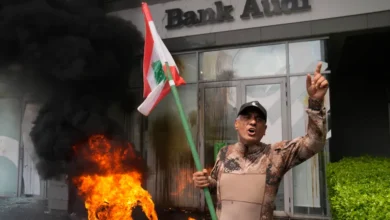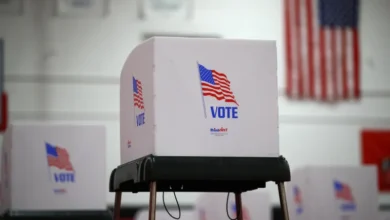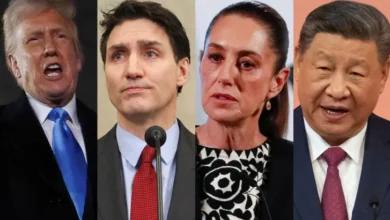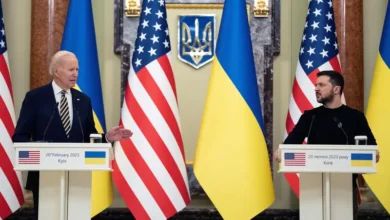US targets Russia with sanctions, tariffs on war anniversary
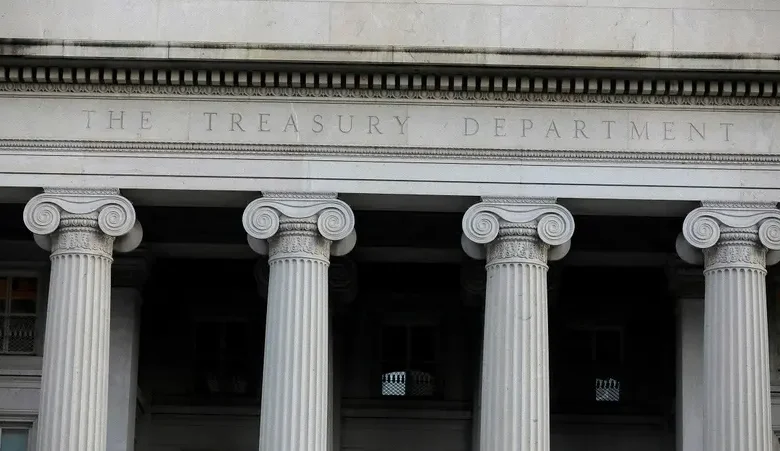
The United States marked the first anniversary of Russia’s invasion of Ukraine on Friday with new sanctions, export controls and tariffs against Russia and its allies aimed at undermining Moscow’s ability to wage war.
Washington also said it would provide another $2 billion in weaponry for Kyiv as it prepares for a spring offensive. The aid did not include F-16 fighter jets that Ukraine has requested.
President Joe Biden consulted leaders of the G7 bloc of wealthy nations and Ukrainian President Volodomyr Zelenskyy to discuss more aid.
The United States joined with G7 allies with plans to impose sanctions that will target 200 individuals and entities and a dozen Russian financial institutions.
They planned to form an “Enforcement Coordination Mechanism,” at first chaired by the United States, to counter Russian efforts to circumvent the sanctions.
The sanctions are aimed at targets in Russia and others across Europe, Asia and the Middle East supporting Russia’s war effort, the White House said in a fact sheet.
“We will sanction additional actors tied to Russia’s defense and technology industry, including those responsible for backfilling Russian stocks of sanctioned items or enabling Russian sanctions evasion,” it said.
Treasury Secretary Janet Yellen warned China, including Chinese firms and banks, against helping Russia evade sanctions.
“We’ve been very clear from the outset with China and with other countries that providing material support to Russia in evasion of sanctions would provoke very serious consequences,” she said on MSNBC.
The US State Department imposed sanctions on more than 50 top Russian officials, including cabinet ministers and dozens of governors and regional chiefs.
The department said it also was imposing sanctions on scores of other Russian officials and entities, plus visa restrictions on more than 1,200 members of the Russian military.
They included top aides to Russian President Vladimir Putin, Olga Skabeyeva, a leading propagandist on state television, and Oleg Romanenko, who was appointed to oversee Ukraine’s Zaporizhzhia Nuclear Power Plant after it was seized by Russian troops.
There was no immediate response from Moscow, which has slapped its own sanctions on some Western nations and accuses Washington and others of leading a global campaign to destroy Russia.
Extra costs on Russian imports
Treasury included penalties on more than 30 individuals and companies from Switzerland, Germany and other nations for helping Moscow finance its war against Ukraine. The new measures hit 22 Russian individuals and 83 entities, Treasury said.
Biden signed proclamations to raise tariffs on Russian products imported to the United States. They will result in increased tariffs on more than 100 Russian metals, minerals and chemical products worth about $2.8 billion to Russia.
“It will also significantly increase costs for aluminum that was smelted or cast in Russia to enter the US market in order to counter harm to the domestic aluminum industry,” the White House said.
The US Commerce Department will impose export controls on nearly 90 Russian and third-country companies, including in China, for engaging in sanctions evasion in support of Russia’s defense sector and prohibit them from buying items like semiconductors.
Commerce will also act with G7 allies to align measures on industrial machinery, luxury goods and other items, as well as issue new restrictions to prevent components found in Iranian drones from making their way to the Ukraine battlefield, the White House said.
Biden has spent the past year rallying US allies against Russia’s invasion.
While multiple rounds of Western sanctions have damaged the Russian economy, Putin can still fund his war and there is no end in sight to the conflict.
The United States planned to announce $250 million in aid to shore up Ukraine’s energy infrastructure in the face of Russian attacks. Moldova will get $300 million to help wean itself from energy dependence on Russia.
The Pentagon said the additional $2 billion in military aid for Ukraine includes more ammunition for the High Mobility Artillery Rocket Systems (HIMARS) and a number of different types of drones including Switchblades and the CyberLux K8.
The weapons will come from the Ukraine Security Assistance Initiative, which allows the Biden administration to get weapons from industry rather than from US weapons stocks.
The Biden administration has committed more than $32 billion in military aid over the past year to Ukraine, including 8,500 Javelin anti-armor systems and 38 HIMARS, according to the Defense Department.

